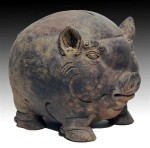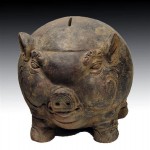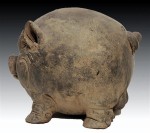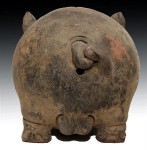Containers with slots have been used as home savings banks since ancient times. A miniature Greek temple from the 2nd or 1st century B.C. was found in the Ionian town of Priene (now in Turkey) with a slot in the pediment to drop coins through and an opening in the back that could be locked and unlocked to retrieve the loot. Money boxes in China made out of clay or porcelain that had to be smashed for the contents to be retrieved were used for official purposes, to ensure money collectors could not easily help themselves, at least as early as the Han Dynasty in the 2nd century B.C.
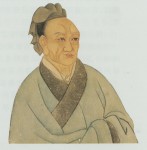 The Records of the Grand Scribe, a massive multi-scroll history of China written by Sima Qian between 109 and 91 B.C., include a morality tale about one of these clay banks. Gongsun Hong, a high ranking minister and eventual Marquis of Pingjin, was born in poverty and worked as a jail warden and pig herder and various other odd jobs for the first half of his life. He began to study the ancient Confucian chronicles of the state of Lu and passed the scholarly exams with flying colors when he was 40 years old, garnering him a professorial appointment at the court of the Han Dynasty Emperor Wu (reigned 141-87 B.C.). Before he left his village to start his new life, an old man told him to take the lesson of the piggy bank: if you stuff yourself full of treasure, you will eventually be smashed. Instead, live frugally, like the humble clay money box itself. That way you’ll earn your money gradually, honorably, and nobody will be looking to bust you open to get to riches within. Gongsun Hong took the elder’s advice and became known far and wide for his honesty, plain living and incorruptibility.
The Records of the Grand Scribe, a massive multi-scroll history of China written by Sima Qian between 109 and 91 B.C., include a morality tale about one of these clay banks. Gongsun Hong, a high ranking minister and eventual Marquis of Pingjin, was born in poverty and worked as a jail warden and pig herder and various other odd jobs for the first half of his life. He began to study the ancient Confucian chronicles of the state of Lu and passed the scholarly exams with flying colors when he was 40 years old, garnering him a professorial appointment at the court of the Han Dynasty Emperor Wu (reigned 141-87 B.C.). Before he left his village to start his new life, an old man told him to take the lesson of the piggy bank: if you stuff yourself full of treasure, you will eventually be smashed. Instead, live frugally, like the humble clay money box itself. That way you’ll earn your money gradually, honorably, and nobody will be looking to bust you open to get to riches within. Gongsun Hong took the elder’s advice and became known far and wide for his honesty, plain living and incorruptibility.
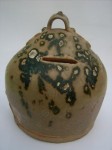 By the Tang Dynasty in the 9th century A.D., the official clay money boxes of antiquity had transformed into the household savings devices, especially for children, that piggy banks are today. An inscription on the clay bank on the right notes that it was made in 867 A.D. to celebrate the birth of a child. Coins or good luck charms (which in China were often cast to look like the round coins with the square cutout in the middle) would have been slid through the slot for the birthday boy.
By the Tang Dynasty in the 9th century A.D., the official clay money boxes of antiquity had transformed into the household savings devices, especially for children, that piggy banks are today. An inscription on the clay bank on the right notes that it was made in 867 A.D. to celebrate the birth of a child. Coins or good luck charms (which in China were often cast to look like the round coins with the square cutout in the middle) would have been slid through the slot for the birthday boy.
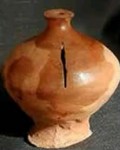 The piggy bank in the history of English speaking countries was born from a trick of language. In medieval England, an orange clay called “pygg” (pronounced “pug” in Middle English) was used to make a variety of inexpensive household containers, including coin jars. Again, the pygg jars had a small opening or slot to slide coins into but would have to be broken for the coins to be retrieved.
The piggy bank in the history of English speaking countries was born from a trick of language. In medieval England, an orange clay called “pygg” (pronounced “pug” in Middle English) was used to make a variety of inexpensive household containers, including coin jars. Again, the pygg jars had a small opening or slot to slide coins into but would have to be broken for the coins to be retrieved.
Then came the Great Vowel Shift. Between 1400 and 1700, English vowels came to be formed increasingly higher up and forward in the mouth. This turned the “pug” sound of “pygg” into “pig,” and although by the 18th century pygg was no longer the commonly used clay, the name had stuck, thus giving artisans a new design theme in the creation of money boxes for the home. Because their total destruction was a key design element, very few of these have survived. The addition of a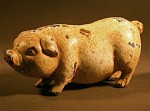 removable plug in the 19th century ushered in the era of the collectible piggy bank.
removable plug in the 19th century ushered in the era of the collectible piggy bank.
Post-Great Vowel Shift England wasn’t the first to make adorable coin banks in the shapes of pigs, however. That honor goes to the Majapahit Empire of Southeast Asia. Based on the island of Java, the Majapahit Empire reigned over what is today the Indonesian archipelago from 1293 to 1500. After defeating an invasion fleet of Mongol Emperor Kublai Khan, Majapahit settled into a mutually beneficially trading relationship with China and other countries whose ships, laden with spices and other merchandise, passed through the archipelago.
 Somewhere around 1300, an enormous quantity of Chinese copper kepeng coins were imported into Majapahit. Although Java had had a gold and silver coin economy for centuries by then, the increase in non-agricultural prosperity under the Majapahit Empire created a new need for lower value cash with which to purchase goods and services. After the initial imports, the Majapahit began to cast copper coins of their own in the shape of the Chinese kepeng. Once regular people started having cash on hand, they needed a place to store it at home. Enter the first pig-shaped piggy banks.
Somewhere around 1300, an enormous quantity of Chinese copper kepeng coins were imported into Majapahit. Although Java had had a gold and silver coin economy for centuries by then, the increase in non-agricultural prosperity under the Majapahit Empire created a new need for lower value cash with which to purchase goods and services. After the initial imports, the Majapahit began to cast copper coins of their own in the shape of the Chinese kepeng. Once regular people started having cash on hand, they needed a place to store it at home. Enter the first pig-shaped piggy banks.
A celeng is a wild boar native to the jungles of Java. As with all its porcine cousins, these boars are fertile, have large appetites and enjoy wallowing in the earth. As such they are symbols of prosperity, of good fortune and of a connection to spirits of the earth. It makes sense, therefore, that clay taken from the earth would be shaped into a fat little pig and used for keeping coins. Prosperity literally lies within its adorable round belly.
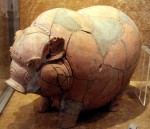 By the 15th century, terracotta piggy banks were made in all shapes and sizes. They were extremely common across all classes. Large numbers of them, most of them broken, have been excavated around the Majapahit capital of Wilwatikta (modern Trowulan). There are several examples on display at the National Museum of Indonesia in Jakarta, including this one to the right which was pieced back together from fragments by conservators.
By the 15th century, terracotta piggy banks were made in all shapes and sizes. They were extremely common across all classes. Large numbers of them, most of them broken, have been excavated around the Majapahit capital of Wilwatikta (modern Trowulan). There are several examples on display at the National Museum of Indonesia in Jakarta, including this one to the right which was pieced back together from fragments by conservators.
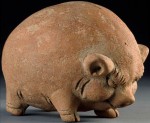 Intact ones are rare, of course, since you have to smash them to get your money, but here’s a 15th century one made out of terracotta in Oxford University’s Ashmolean Museum. If you have $5,000 in your piggy bank at home, take a hammer to it so you can buy this 15th century one in painted red clay. There’s no way your piggy bank is as adorably rotund of belly (and testicle) as the Majapahit one.
Intact ones are rare, of course, since you have to smash them to get your money, but here’s a 15th century one made out of terracotta in Oxford University’s Ashmolean Museum. If you have $5,000 in your piggy bank at home, take a hammer to it so you can buy this 15th century one in painted red clay. There’s no way your piggy bank is as adorably rotund of belly (and testicle) as the Majapahit one.
